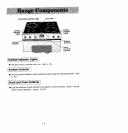
• Donotusecookwarethat extendsmorethan1inchbeyondtheedgeoftheelement.
• Donotuseasmall cookpotona largeelement. Notonlycan thiscausetheelement
torequiremoreenergyandtime,butitcanalsoresult inspilloversburning ontothe
elementwhich cause extra effortin cleaning.
• Do not usenonflat specialty itemsthat are oversized,uneven or do not meet
propercookwarespecificationssuch as round bottomwokswith rings, griddles,
rippledbottomcanners,lobsterpots,largepressurecanners,etc. Forwokcooking,
useJenn-Air flat bottom wok (ModelAO142). (See p. 12.)
Acceptablecanningpots shouldnot be oversizedand musthavea flat bottom. When
canners do notmeet these standards,the use of the Hi heatsetting becomesexces-
sive and may result in damageto the cooktop. In addition, water maynot come to a
boil and canners may not reach 10 lb.of pressure.
The acceptablecanning procedureuses the Hi settingjust long enough to bring the
water to a boil, then lowerthe settingto maintainthe water temperature.
Heavy gauge cookpots with flat, smooth bottoms will usually work in a similar way.
However,thereare somedifferencesin thecooking performanceof various materials.
• Aluminumcookpotsheatquicklyand evenly. Best suited forsimmering,braising,
boilingand frying.
• Stainless steel cookpots will evenly distribute heat if constructed of tri-ply or
combined with other metals such as aluminum and copper. Use for cooking
functionssimilar to aluminum.
• Cast iron cookpots are slow to heat but cook more evenly oncetemperature is
reached. Use for long term lowheatcooking or for browningand frying.
• Glass ceramic, earthenware,heat-proofglass orglazed coekpotscan be used if
recommendedby the manufacturerfor cookpot cooking. Do not usewith trivets.
Best usedon low to mediumcontrol settings.
• Porcelain enamel-on-steel or porcelain enamel-on-cast iron should be used
accordingto manufacturer'sdirections. Donot allow to boil dry.
15


















